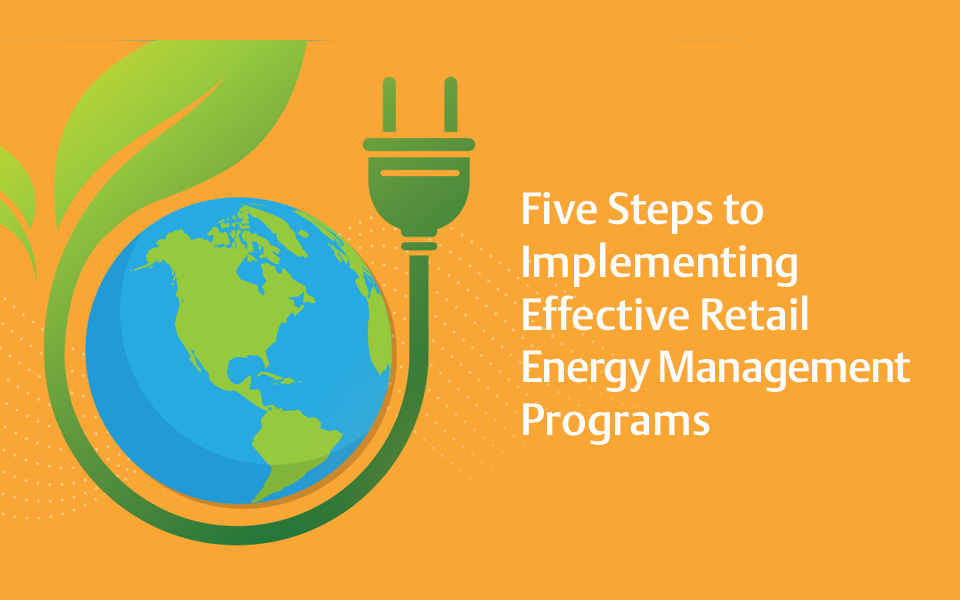Five steps to implementing effective retail energy management programs

*On June 1, 2023 Emerson’s Climate Technologies business became a new standalone company – Copeland. Though our name has changed, we are building on more than a century of HVACR innovation and industry leadership, and Copeland continues to offer the same products, industry stewardship, and learning opportunities you’ve grown to trust. Information found on this webpage posted before June 1, 2023 may contain our old name or branding, but you can be at ease knowing it was created with the knowledge and expertise of Copeland.
For most companies in the food retail and foodservice sectors, implementing an energy management program that drives efficiencies and reduces costs has been an elusive goal. Doing so requires the in-house expertise needed to navigate the labyrinth of regional utilities, private electric cooperatives, local governments and state agencies. For a recent article published in Today’s Grocer (p. 4), I provided an overview of the complex power market landscape and discussed five steps that retailers should consider for achieving a successful implementation. To view the full article, click here.

Understanding store energy profiles
According to the Department of Energy (DOE), roughly $3.6 billion in rebates, incentives and demand response programs are available annually in the commercial sector. The concept of energy management is gaining traction within that sector, where many retailers are driven by corporate sustainability initiatives and emerging environmental regulations. It’s no surprise that more than 80 percent of companies reported they have upgraded a refrigeration system within the last three years, with 60 percent planning upgrades or remodels on a five- to ten-year cycle.
A typical supermarket uses approximately 50 kilowatt-hours (kWh) of electricity and 50 cubic feet (ft) of natural gas per square foot each year — an average annual energy cost of more than $4 per square foot. In a 50,000 square foot store, this equates to more than $200,000 annually in energy costs and results in 1,900 tons of CO2 being emitted into the atmosphere — the equivalent total emissions from 360 vehicles in one year.
Restaurants consume roughly five to seven times more energy per square foot than other commercial buildings. For high-volume, quick-service restaurants (QSRs), energy consumption may reach 10 times that of other commercial facilities. Refrigeration, lighting and cooling (HVAC) are among the most energy-intensive restaurant equipment.
Participating utilities and power markets seek to mitigate these high energy consumers by partnering with supermarkets and restaurants to install more efficient equipment and deploy smarter energy management strategies. If your company is embarking on this transition, then selecting energy-efficient equipment that would qualify for incentives could deliver many potential benefits:
- Maximize CAPEX investments and offset costs
- Lower operating expenses through improved energy efficiencies
- Reduce maintenance costs with newer, smarter equipment
- Lay a foundation for future energy optimization
The journey to energy management
Today, very few companies have the internal energy management resources to secure utility rebates or establish an infrastructure necessary to support longer-term energy optimization strategies. As a result, they miss opportunities to apply these incentives toward critical equipment upgrades or support cooperative programs that could deliver ongoing energy savings, such as automated demand response (ADR) and/or energy aggregation arrangements.
As an expert solution provider, Copeland partners with retailers to help them coordinate with other power market players — such as utility companies and implementers — to facilitate successful energy management projects. The first steps on this journey are to perform a benchmark of your existing facilities and decide which equipment and systems are the best candidates for replacement.
- Evaluation. Copeland can help you with this process by focusing on store locations and equipment which would offer optimum return on investment (ROI). We evaluate the following criteria when making these recommendations:
- Under-performing or outdated equipment
- Equipment categories with the highest potential for incentives/dollars
- Upgrades that could deliver ongoing energy improvements and cost savings
- The potential to support energy curtailment and/or demand response programs that generate passive revenue
- Initiation. Our energy management team helps you to engage the utility and/or implementer and share our optimization project findings:
- Estimate the current energy baseline
- Recommend equipment that qualifies for incentives
- Calculate the potential ROI
- Benchmarking. Once you’ve made the necessary equipment replacement decisions, the implementer team benchmarks the current energy performance baseline based on the type of incentive:
- Pre-determined dollar amount for upgrading to a qualifying piece of equipment (one-time incentive)
- Custom energy management program that requires more advanced data logging and analysis, yet represents the potential for ongoing savings (long-term, continuous incentive)
- Installation and validation. Once our team leads the installation of new equipment, the implementer measures its performance to validate that it meets the energy reductions needed to qualify for incentives.
- Monetization. Upon verification of efficiency data, the utility then can release incentive payments. In addition, retailers realize the ongoing energy savings from the upgraded equipment.
To begin your engagement and implement more effective energy strategies that can support your sustainability initiatives and grow your bottom line, contact Copeland’s energy management experts at [email protected]. Visit our website to learn how we’re helping retailers to kick-start their energy management initiatives.

8 proven strategies for rigorous cold chain management
by Dan Knauer | Cold Chain
Preparing for the approval and safe use of A2Ls in commercial refrigeration applications...
Protection for high-value shipments just got even better
by Alex Axelsson | Cold Chain, Transportation
We’re excited to announce the release of Copeland’s newest real-time tracker, the GO Real-Time...

Three proven strategies to prevent cargo theft
by Chris Lafferty | Cold Chain, Transportation
The over-the-road (OTR) transport industry is experiencing a surge in cargo thefts. As thieves...
The post Five Steps to Implementing Effective Retail Energy Management Programs appeared first on Copeland.